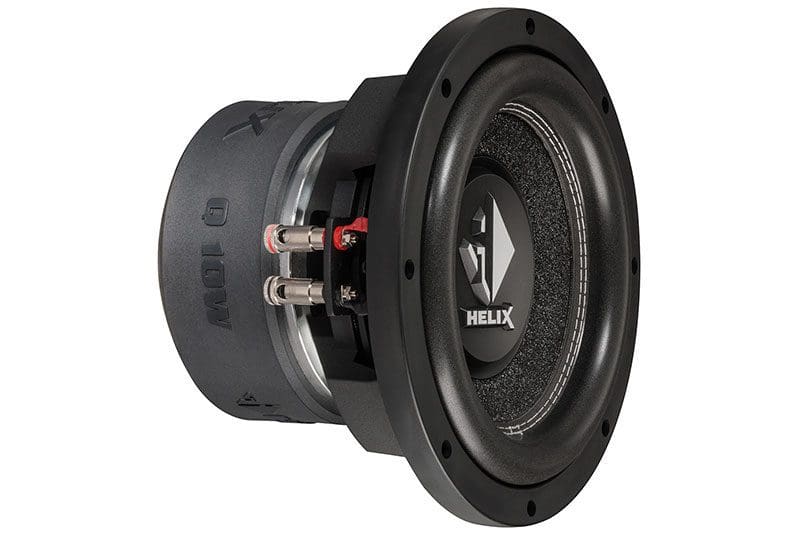For car audio enthusiasts who’ve invested time studying the Thiele/Small parameters of speakers and subwoofers, you’ll know there is a specification called Xmax. This variable, typically expressed in millimeters or inches, is intended to describe the one-way excursion capability of the driver. Put another way, it’s the distance the cone can move forward or rearward from its rest position before distortion overwhelms the signal being produced.
Mechanical Xmax Calculations
The simplest way to calculate the Xmax specification is to subtract the thickness of the top plate from the height of the voice coil winding and divide it by two. This calculation describes how far the woofer (or midrange or subwoofer) cone can move forward while keeping the voice coil inside the magnetic gap. If and when the coil attempts to move out of the gap (determined by the thickness of the top plate), the strength of the magnetic field is dramatically reduced and the output of the speaker becomes non-linear. If the audio signal being produced by the speaker isn’t the same as the signal sent from the amplifier, significant distortion is being added to the signal, and your music won’t sound right.




It’s worth having a baseline for values that are considered normal and impressive in terms of Xmax. Tweeters seldom have an Xmax specification, but that doesn’t mean it’s not a value that can be calculated. For example, a linear excursion of plus or minus 0.2 mm (0.0079 inch) would be an excellent specification for a tweeter. For a small 3- or 4-inch midrange driver, an Xmax of plus and minus 2 mm would be good, and greater than 4 mm would be excellent. For a 6.5-inch mid-woofer intended for a door speaker application, an Xmax value of 4 mm would be good, and anything above 8 mm would be exceptional.
Subwoofer excursion capability increases dramatically as the price of a driver increases. For entry-level 10- and 12-inch subwoofers, rated for 300 to 450 watts, an Xmax of 10 to 12 mm is good. Stepping up to mid-level woofers with power ratings between 500 and 600 watts typically results in the Xmax spec jumping up to 14 or 16 mm in each direction. The cream of the crop in subwoofers offer Xmax capabilities beyond 18 mm, with some drivers capable of more than 24.5 mm (1 inch) of excursion in each direction. Shallow-mount subwoofers typically scale these values down a bit, with mid-level drivers capable of 8 to 10 mm of excursion and premium solutions capable of more than 15 millimeters.



Those who care less about sound quality and are interested only in achieving maximum sound pressure levels can continue to increase the power to a speaker beyond the Xmax value. In this scenario, peak SPL measurements are typically all that matter, so sound quality and accuracy take a back seat.
Xmax Isn’t Always a Calculation
A second way to specify the Xmax parameter involves using acoustic test equipment and laser-based cone excursion measurement. Using this method, a signal is fed to the driver being tested at an increasing level until the speaker’s output reaches a distortion level of 10%. These performance-based measurements are crucial as they take into account non-linearities caused by limits in the compliance of the speaker’s suspension components.
For example, if a driver has a 16 mm top plate and a 32 mm voice coil height, the calculated Xmax would be 8 mm. Suppose the surround on the driver is very narrow or stiff and starts to limit cone travel at an excursion level of 5 mm. Once again, the output audio signal won’t replicate the signal from the amplifier, and significant harmonic and intermodulation distortion will be added to the output. The speaker also won’t play any louder. The surround or the spider can cause compliance-based excursion limiting, and these characteristics are usually the limiting factors in how loudly a speaker or subwoofer can play. In the car audio industry, very few manufacturers use the Xmax+10% specification method as investing in the test equipment is very expensive.

Though it isn’t as common as it was years ago, another mechanical measurement affects how loudly a speaker can play. If the bottom of the voice coil former runs into the bottom plate of a speaker, you’ll hear a very sharp snapping sound. Of course, this limits excursion and can damage the former very quickly. This situation happens when the suspension components aren’t stiff enough or if the driver is designed to be extremely shallow and there isn’t adequate space at the bottom of the driver.

One Last Thought on Xmax Specifications
If you’re shopping for a subwoofer, the Xmax spec isn’t the be-all, end-all in determining how loudly the subwoofer system will play. The way the driver interacts with the enclosure plays a huge role in determining the audio system’s effective efficiency and low-frequency extension. Check out our articles on speaker specifications and subwoofer enclosure designs for more insight into this topic.
When it’s time to choose the right subwoofer for your car or truck, drop by your local specialty mobile enhancement retailer and talk with them about your expectations and the speakers and subwoofers that are the best for your application. Be sure to audition one of their demo vehicles to see if the subwoofer solution meets your performance goals.

